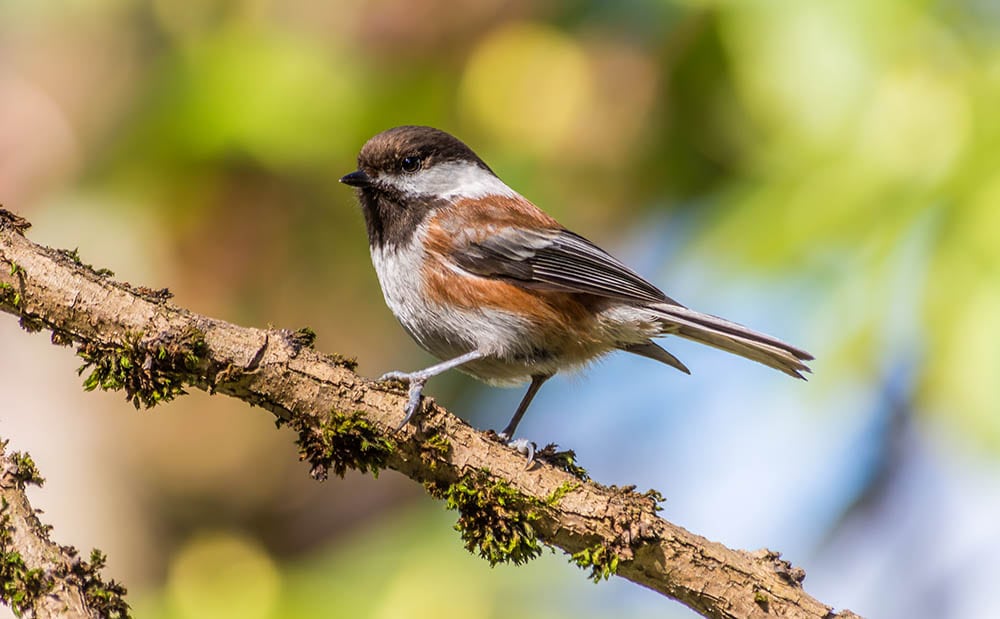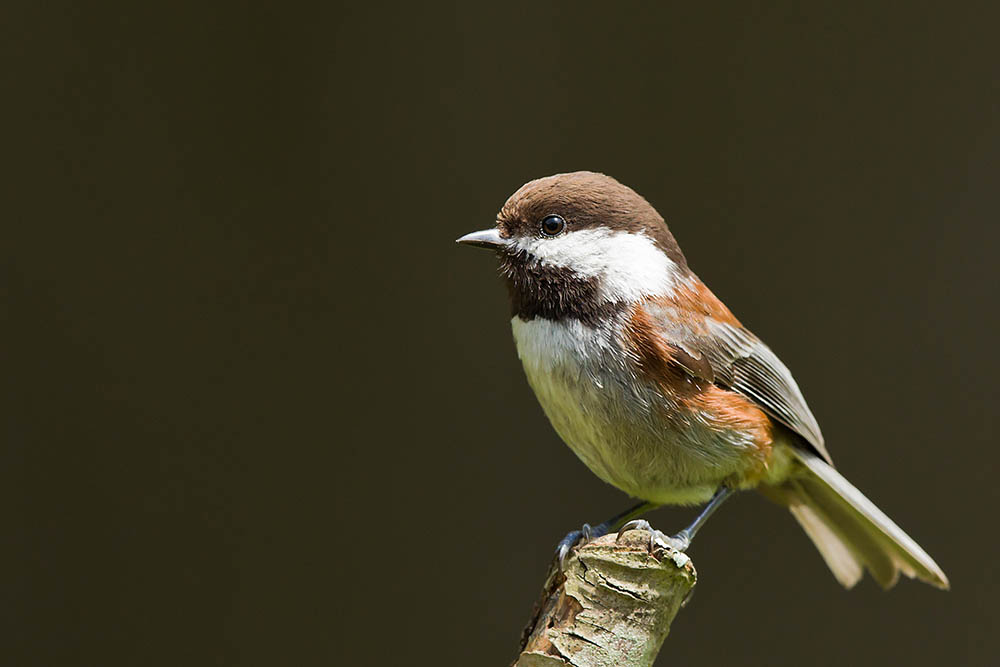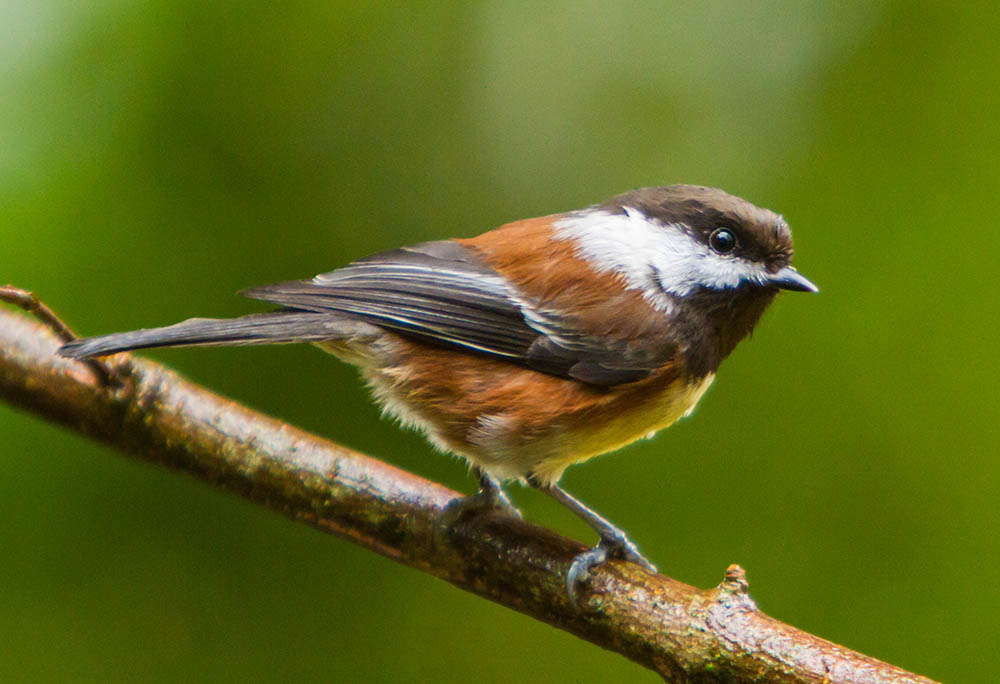Chestnut-Backed Chickadee: Field Guide, Pictures, Habitat & Info
Last Updated on

The Chestnut-backed Chickadees are one of the most colorful Chickadee species. Their small, puffy build and short purple legs make them stand out from other birds in their species and they’re among the smallest and longest-tailed Chickadees. They have distinctive dark chestnut feathers on their head, maple feathers on their back, and light-colored bellies which are usually gray or white.
You’ll see them all over midwestern parts of Alaska and throughout various provinces in Canada. Mixed flocks of these birds along with Brown Creepers, Red-breasted Nuthatches, and Golden Crowned Kinglets are often seen in winter foraging for fruit and nuts in the same regions.

Quick Facts about Chestnut Backed Chickadees
| Habitat: | Wet, damp forests, moderate to cold climates |
| Diet: | Mostly insects in addition to nuts and seeds |
| Behavior: | Sedentary, typical foragers |
| Nesting: | Tree cavities, shrubs |
| Conservation: | No |
| Scientific name: | Poecile rufescens |
| Lifespan: | 4 years |
Chestnut-Backed Chickadee General Description
This Chickadee is agile, active, and can be heard singing in forests all over the northern regions of North America. The Chestnut-backed Chickadee is the smallest Chickadee and has the longest tail. It’s found in wet, dense spruce forests and has a dark brown cap with a white belly that appears puffed out.
Chickadees have developed the evolutionary ability to withstand Alaska’s harsh winters. Their plumage is denser and more insulating than most other songbirds. They also have a unique ability to quickly gain fat, which is used as fuel to stay warm in winter. A Chickadee can gain up to 7-8% of its body weight each day in fat. They can also drop their body temperature at night to save their winter fuel (aka “fat”).

Chestnut Backed Chickadee Range, Habitat, Behavior, Diet & Nesting
Range
The Chestnut-backed Chickadees can be found in coniferous forests along Alaska and California’s long coast. They also live in deciduous forests along streams or other woodsy dense areas. They can also be seen at backyard feeders.
The Chickadee is able to stay within its breeding range all year, but will occasionally move during winter and fall. Several flocks can be found roaming over 50-acre winter feeding areas, regularly visiting their food sources.
The birds usually return to their nests in a specific area of trees each night, though some may find shelter under protected areas such as beneath porches, in trees, or under roof eaves.
Habitat
Chestnut-backed Chickadees can be found in moist dense forests along the Pacific coast. If they’re present, they will use the dense cover of forest for protection from predatory wildlife.
Diet
About two-thirds of the Chickadee’s diet is made up of small insects and spiders. However, they’ll also eat seeds, berries, seeds, and fruit if it’s available.

Behavior
Chickadees love to climb up and hop from one branch to the next in search of tiny insects or other food. They often begin in the lowest branch of a tree and work their way up — remember, they have short legs. Sometimes they will act as flycatchers and fly out from perches to catch insects passing by.
Nesting
Chickadees are cavity-nesting birds. So, they love to stay tucked away from predators in areas where they’re out of sight. They’ll hang out in old woodpecker holes and nesting holes made by other birds.
Chickadees will also dig their own cavity from rotting or decayed wood. In subsequent years, nesting birds will often use the same hole again if they’re in the same area.
Song
A Chickadee’s song sounds like long chirps followed by short bursts of shrills. They are not songlike, unlike other species.

How to Find Chestnut Backed Chickadees: Birdwatching Tips
What to Listen For
A squeaky, shrill chirp followed by thin lisping notes.
What to Look For
You can find these small birds high up on tall tree branches or hanging out in small shrubs and bushes in forests, parks, or yards.
When to Look
These birds are usually out all throughout the year — especially when they’re looking for food while they’re nesting. Check for them in the early hours of the morning, as they’re out right before dawn, usually trotting around on the ground in search of grub.

Attracting Chestnut Backed Chickadees to Your Backyard: Tips & Tricks
There are a few ways to invite these beautiful birds to your backyard, and it typically involves food.
Here are some methods to use:
- Provide food and shelter for them by planting shrubs and small trees
- Offer food that chickadees love such as dead insects (spiders, flies, mealworms, ants)
- Buy a bird feeder for chickadees and stock it with food
- Build a nest box or bird house that’s large enough for chickadees to nest in
- Install a small water feeder in your backyard or front lawn
Chestnut-Backed Chickadee Conservation: Is This Bird Threatened?
These birds appear to have stable populations throughout most of their range, though they may have local declines in areas where forests have been destroyed.

Conclusion
Chestnut-Backed Chickadees are small agile birds that can be interesting to watch. They’re native to different areas of Alaska and Canada but may be spotted in other pacific coast regions. If you’re looking to attract these birds to your yard, set out a feeder with food and water and you just may attract them by the numbers.
Featured Image Credit: Marv Vandehey, Shutterstock
Table of Contents
- Quick Facts about Chestnut Backed Chickadees
- Chestnut-Backed Chickadee General Description
- Chestnut Backed Chickadee Range, Habitat, Behavior, Diet & Nesting
- How to Find Chestnut Backed Chickadees: Birdwatching Tips
- Attracting Chestnut Backed Chickadees to Your Backyard: Tips & Tricks
- Chestnut-Backed Chickadee Conservation: Is This Bird Threatened?
- Conclusion
About the Author Robert Sparks
Robert’s obsession with all things optical started early in life, when his optician father would bring home prototypes for Robert to play with. Nowadays, Robert is dedicated to helping others find the right optics for their needs. His hobbies include astronomy, astrophysics, and model building. Originally from Newark, NJ, he resides in Santa Fe, New Mexico, where the nighttime skies are filled with glittering stars.
Related Articles:
10 Types of Hummingbirds in Arkansas (With Pictures)
8 Types of Hummingbirds in Nebraska (With Pictures)
5 Types of Hummingbirds in Idaho (With Pictures)
3 Types of Hummingbirds in Mississippi (With Pictures)
8 Types of Hummingbirds in Kansas (With Pictures)
5 Types of Hummingbirds in West Virginia (With Pictures)
5 Types of Hummingbirds in Ohio (With Pictures)
Where Do Nuthatches Nest? Nuthatch Nesting Habits Explained
